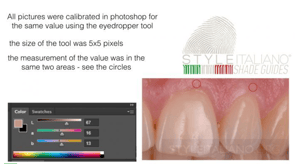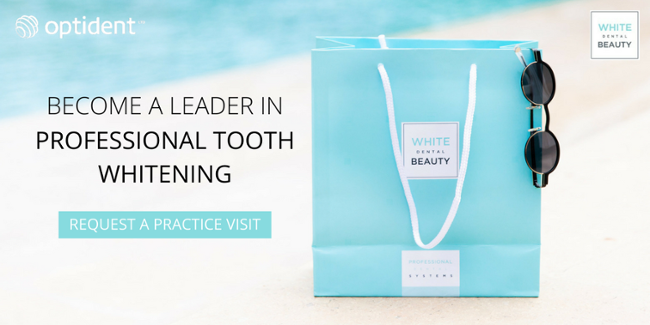Patients have high aspirations of what their smile should look like. A lot of which has to do with the rise of social media and a growing admiration of the celebrity lifestyle.
But whilst they dream of having a perfectly straight, white smile, they also expect dentists to deliver this through minimally invasive treatments. That is why it is more important than ever for the dental professional to remain on their A-game...
Teeth whitening is advancing; now reliable and effective tooth whitening gels are available in concentrations as low as 5% Carbamide Peroxide to help minimise sensitivity caused by the peroxide.
This clinical case reviews the results of a 6% Hydrogen Peroxide teeth whitening system used to whiten teeth with minimum sensitivity to the patient.
 Dan Lazar: Minimum Sensitivity After External Bleaching
Dan Lazar: Minimum Sensitivity After External Bleaching
Dan Lazar is a passionate dentist, specialising in direct composite restorations, anterior prosthodontics and dental photography.
He graduated from the Faculty of Dentistry, Cluj-Napoca, Romania in 2005 and taught from 2007 to 2009 in the Faculty of Dentistry, Restorative department. From 2009 he has lectured on a range of topics including direct composite restorations, anterior prosthodontics and dental photography. Working in a private practice since 2005 in Ordea, Romania, Dan is interested in the aesthetic perception of the smile and the balance of design of the anterior region.
Smile Design and Tooth Whitening Gels
Patients often come to dental practices asking to have their smiles improved as they feel that a ‘beautiful smile’ is something that would make their social lives better. However, potential patients are unaware of treatment options, so it is the dentist’s responsibility to advise the most conservative, desirable treatment.
When patients complain about, to use their words, “ugly teeth” the dentist must determine whether the term ‘ugly’ is the result of the colour or shape of the dentition. Therefore the following questions are appropriate:
- Are you comfortable with the shape of your teeth?
- Do you like the colour of your teeth?
If the answer to the first question is affirmative and colour is the main concern, there are many options but it should always be the least invasive choice that is first suggested to the patient. External bleaching can sometimes be the best option; however the patient should understand that this procedure is a temporary solution and, to maintain the results, they need to follow some instructions, for example minimum smoking, and less intake of drinks that stain teeth.
Bleaching-induced tooth sensitivity has been associated with microscopic surface defects and sub-surface pores in the enamel. Because of the low pH of the in-office bleaching gels available on the market there can be a consequential reduction in enamel micro-hardness. It has been theorised that these defects allow rapid diffusion of the whitening agent into the pulp, resulting in inflammatory reaction and bleaching-induced tooth sensitivity. The association between low pH bleaching gels and the risk of tooth sensitivity is still unclear, however, theoretically, a product that encourages repair of these microscopic defects can reduce, or at least minimise, tooth sensitivity by diminishing diffusion of hydrogen peroxide into the pulp. Consequently, manufacturers have added different compounds such as fluoride, potassium nitrate, and different calcium phosphate salts to bleaching products. Fluoride and potassium nitrate have been frequently used to manage tooth sensitivity with clinical success.
White Dental Beauty has a range of high quality tooth whitening gels includes 6% hydrogen peroxide and 5% 10% & 16% carbamide peroxide with NOVON, providing great versatility and clinical freedom to whiten patients’ teeth with as little as 30 minutes a day active treatment. Powered by NOVON, which uses an intelligent pH acceleration for maximum whitening effect, speeding up the whitening process whilst still being highly effective.
NOVON is a new, patented whitening compound that comprises hydrogen peroxide, urea and sodium tripolyphosphate and is the active ingredient in a new generation of tooth whitening gels. NOVON has a unique inherent feature in that, on application, it produces a ‘pH jump’ into the alkaline pH range. This ‘pH jump’ enhances the release of perhydroxyl ions which give a faster whitening effect. NOVON – containing gels can therefore produce a similar whitening effect within a shorter timeframe, in comparison to whitening using a regular gel. Alternatively, within the same time frame, a similar level of whitening can be achieved using a lower concentration of NOVON (Hyland et al., 2014). This should be an advantage to patients with sensitive teeth.
NOVON has 4 options for home bleaching:
- 6% Hydrogen Peroxide from as little as 30 minutes a day
- 16% Carbamide Peroxide from as little as 60 minutes a day
- 10% Carbamide Peroxide 2-4 hours overnight
- 5% Mild Carbamide Peroxide 2 hours a day
Preparation and Case Procedure
In this case, 6% Hydrogen Peroxide for 30 minutes a day was used over a period of 14 days.
A bleaching custom tray was made and the patient was instructed on how to use the 6% Hydrogen Peroxide bleaching gel. The patient was asked to keep a journal, during and after the bleaching procedure, reporting on the grade of tooth sensitivity, from 0 to 10 (where 0 is the absence of sensitivity and 10 is high sensitivity).

In the first session a picture was taken with the VITA shade to establish the initial situation. Each image used in this case was calibrated at the level of the gingiva using Photoshop CS with the CIE Lab colour measurement. From this data we extract the L data, representing the value and calibrated the other pictures using levels so that all pictures were at the same exposure (Fig. 1).
Pre-Operative View
For comparison the initial smile (Fig. 2), intraoral view (Fig. 3) and VITA shade colour tray (Fig. 4) were all captured. These pictures are all very important for both dentists and patients. The home bleaching procedure provides a progressive change of shade. Patients tend to look in the mirror many times a day to analyze the effect, so that it can be unobservable to them. By comparing the initial and final situation pictures we can demonstrate the colour change.






After 8 Days
8 days progress using the HP 6% for 30 min/day in the smile view (Fig. 5), intraoral view (Fig. 6) and VITA comparison (Fig. 7).






After 14 Days - Final Results
14 days progress using the HP 6% for 30 min/day in the smile view (Fig. 8), intraoral view (Fig. 9) and VITA comparison (Fig. 10).






The VITA comparison from the pre-operative view to the final results show a shade transformation from A3 to A1 in 14 days.

White Dental Beauty Gels are specifically formulated, packaged and delivered with your patients in mind, ensuring you have everything you need to offer them a successful whitening treatment.
White Dental Beauty's whitening products are available worldwide from your local distributor including Optident for the UK. To order in the UK visit the White Dental Beauty manufacturer page or call +44 (0) 1943 60 50 50.

